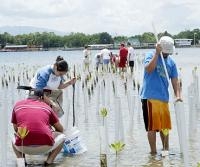Sowing mangrove to save Isla de Ratones
Submitted on 23 July 2006 - 10:15am
This article is reproduced by CienciaPR with permission from the original source.

By Ricardo Cortés Chico / rcortes@elnuevodia.com
endi.com
Around 400 floating seeds of red mangrove were added yesterday to the natural inventory of Isla Ratones landscape, a little island in the coast of Joyuda in Cabo Rojo.
Because of the threat that erosion poses for this little island, around 30 students, professors and environmentalists worked on restoring the mangrove swamp that once existed there.
“This is a way to avoid erosion, which is what is affecting this island. The tide and currents are damaging it because the mangrove swamp that was here, that avoided erosion, was eliminated. This has reduced the size of the island in about 45%”, said Luis Valderrama, executive director of Caborrojeños Pro Salud y Ambiente (Caborrojeños Pro Heath and Environment).
He explained that the first phase of the project was in early 2005 when the organization, together with students and professors of the Inter-American University in San German, sowed 600 seed of red mangrove and five species of coral in an artificial reef.
This fist sow its almost intact and some trees have grown up to 2 feet.
Ilse Sanders, Biology professor of the Inter-American University in San German, pointed that for the sow they would us the Relay Encapsulated Method, which protect the seed using PVC tubes until it grows to a self-sufficient state. This growth can take 3 to 5 years.
During this period, both the environmentalist group as well as students evaluates the plants survival, their growth rate and marine life that arise around this important ecosystem.
“The mangrove and the reef will avoid erosion and help recuperate sediments. Also, it creates a marine habitat that does not currently exist in this area. We will be doing census of the fishes that inhabit the reef and monitoring the growth of the mangrove”, she said.
Both the university and the environmentalist group contemplate, among their future projects, posting underwater signs in the artificial reefs area so they can serve as a sub-aquatic path and sowing more plants. The project’s cost was $40,000 and it was funded by the Gulf of Mexico Foundation.







